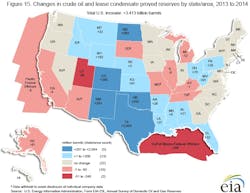At yearend 2014, US crude oil reserves reached nearly 40 billion bbl for the first time since 1972, according to the US Energy Information Administration.
In its latest survey released Nov. 23, EIA noted that proved reserves of oil and lease condensate reached 39.9 billion bbl at yearend 2014—an increase of 3.4 billion bbl from 2013.
According to EIA, this marks the sixth consecutive increase in oil reserves. Proved natural gas reserves, meanwhile, increased 9.8% to 388.8 tcf at yearend 2014, marking the second consecutive increase of proved gas reserves.
EIA’s report cites 2014 as the fourth-highest reserves estimate for US crude. Highlights include Texas’ addition of 2.1 billion bbl from the state’s portion of the Permian basin and the Eagle Ford shale. North Dakota added 0.4 billion bbl mostly from the Bakken shale.
The highest proved reserves additions of gas were from Pennsylvania’s Marcellus shale where operators added a net 10.4 tcf to 2014 estimates.
Several other states contributed to gas reserves growth in the US. West Virginia surpassed Wyoming and Colorado to become the fourth-largest state for proved gas reserves. Ohio more than doubled its gas reserves in 2014 due to further development of the Utica shale. Idaho also reported gas reserves for the first time in 2014.
Sustained low prices for oil and gas are expected to reduce reserves number for EIA’s next report (for yearend 2015). Drilling has curtailed throughout much of the US, and lower prices have made recovery economics more challenging. Since Aug. 21, the overall rig count has fallen 118 units (OGJ Online, Nov. 23, 2015).
Resource estimates are not reduced by lower prices, however, the calculation of proved reserves is sensitive to price, EIA said.


